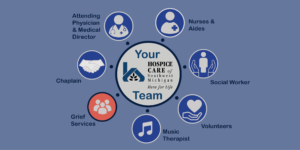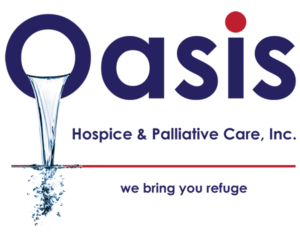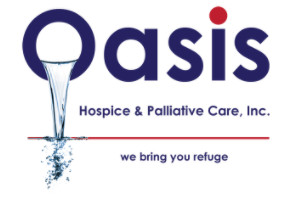So, what is Hospice Care?
Hospice is described as:
Medical care and treatment that enables a person with a terminal illness to live as comfortably as possible for as long as possible while also improving their quality of life.
Hospice care involves an interdisciplinary team of practitioners who concentrate on the dying person and their entire family to explore address physical, psychosocial, and spiritual distress.
Symptom control, continuity of treatment, communication and decision-making, clarity of care priorities, and quality of life are all addressed in this type of care.
Hospice care is given in the patient’s home, which may be their own home or the home of a loved one, a hospital, an assisted living facility, or a nursing home. Some hospices have their own long-term rehabilitation facility where they offer hospice services in America.

When is the right time to consider Hospice care?
It’s impossible to know when it’s time for hospice care and should be addressed with loved ones and a physician. Reasearch shows that it’s usually time to consider hospice when:
- According to a doctor, the patient has 6 months or less to live.
- Despite medical attention, the patient is increasingly deteriorating (weight loss, mental status decline, inability perform activities of daily living).
- The patient is willing to live more comfortably and forego life-prolonging therapies to remain active.
List of Hospice Services & Care for your Loved One close to End of life

The vast majority of hospices adhere to Medicare requirements to provide, as required, the following services to treat the illness for which someone is receiving hospice care:
- Time and services provided by the care team, including visits by the hospice physician, nurse, medical social worker, home-health aide, and chaplain/spiritual advisor to the patient’s site.
- Medications for symptom relief or symptom regulation
- Hospital items such as bandages and catheters, as well as medical appliances such as wheelchairs or walkers
- Occupational and physical therapy
- Care in speech-language pathology
- Dietary guidance
- Any other Medicare-covered programs recommended by the hospice team to treat pain and other symptoms related to the terminal illness.
- Inpatient treatment for a short period of time (e.g. when adequate pain and symptom management cannot be achieved in the home setting)
Respite treatment (e.g., temporary relief from caregiving to prevent or address “caregiver burnout”) is a type of short-term care.
Counseling for patients and their loved ones who have experienced a loss.
Who is Eligible for Hospice Care? Get the Help you Need
Hospice is often associated with cancer, which is understandable. When hospice first arrived in the United States in the mid-1970s, the majority of hospice patients were terminally ill. Today, more than half of hospice patients have other conditions for which they are medically qualified for hospice care, such as advanced Alzheimer’s disease or dementia, as well as late-stage heart, lung, or kidney disease. Hospice was once only for adults, but many services now welcome babies, teenagers, and adolescents.
Medical Eligibility for Hospice Care – Oasis Hospice and Palliative Care
A hospice physician and a second physician (often the individual’s attending physician or specialist) must certify in a plan and find that the patient meets specific medical eligibility requirements in order to obtain hospice services; in most cases, the patient’s life expectancy is 6 months or less if the illness, disease, or condition runs its course. If the person lives longer than six months and their condition worsens, a physician or nurse practitioner may recertify them for hospice care for a longer period of time. In the same way, if a hospice patient’s health improves, they can be released from the program. If the patient’s condition worsens, he or she will be qualified for hospice once more.

Referring Elderly for Hospice Care
Patients and families’ most common concern about hospice treatment is that they were not told about the realistic benefits; there was so much discussion about the theory of care and not enough about who can help and how. [number 16] While controlling symptoms and maintaining physical comfort are crucial, patients and their families face a variety of practical, emotional, and spiritual issues that cause suffering.
The hospice coordinates and pays for all services and prescriptions related to the primary hospice condition when patients choose MHB coverage. Patients with routine Medicare coverage will continue to receive treatment for diseases unrelated to their advanced illness (for example, continued dialysis for renal failure if the patient is dying of cancer). The Medicare Hospice Benefit Model is used by the majority of Medicaid and commercial insurers to cover hospice care insurance.
Palliative care vs. hospice care
Many people have misconceptions regarding what palliative and hospice treatment entails, according to a 2019 survey. Although they have certain similarities, they are not the same.
Both forms of treatment aim to enhance a person’s quality of life by managing symptoms and addressing other essential psychosocial needs.
Hospice care, on the other hand, does not always go hand in hand with curative treatment. Palliative care is often given to people who are suffering from a severe illness.
When a person with a serious illness is nearing the end of their life, hospice care is given. The treatment they undergo is primarily for the purpose of alleviating their symptoms and minimizing any disease-related complications.
Aside from that, palliative care teams are distinct from the primary medical care team that treats a patient’s disease. On the other hand, hospice care teams coordinate the bulk of a person’s care.
Oncology Impact for Hospice Care
The majority of patients with advanced cancer have a predictable disease course. The use of more oncology chemotherapy and radiotherapy at the end of life has had little effect on this trend. The time it takes for an adult with advanced solid tumors to go from symptomatic to death is 4 to 6 weeks. Among the other factors listed, poor performance status is still the most significant prognostic factor. The data is in, and hospice care is the highest quality of care for cancer patients, not an alternative. Payers for high-quality cancer treatment will expect a referral with a care interval—generally 4 to 6 weeks after enrollment—as a measure of the oncologist’s quality cancer care. Prognostic data is outlined in this report, along with a recommended method for addressing hospice enrollment with patients.
Home hospice has been widely available in the United States since 1982, when Congress established the Medicare Hospice Benefit for patients with advanced illnesses who have only 6 months to live. Despite the fact that national guidelines regularly recommend that referral to hospice care is the best option for medical treatment of patients with end-of-life needs, only about half of all cancer patients who die are ever referred. [1-3] Patients admitted to hospice frequently only live for a few days, undermining the possible advantages of a coordinated approach to treatment by the hospice team over a longer period of time for patients and their families.
Summary for Hospice Care
For people who face the end stages of a terminal illness, hospice care can help ease pain, discomfort, and other symptoms. This type of care can help people live their final days as fully and comfortably as possible.
While they treat symptoms, hospice care teams also communicate with family members and provide 24/7 support. They also help terminally ill people and their loved ones make difficult decisions regarding end-of-life care.
Hospice care workers provide emotional support to terminally ill people, and their families, before and after their death.
Does hospice seem like the right decision for your family? Consult a specialist at Oasis Community Hospice Care to explore options today. Consultations are free but life is worth more than gold. Let us help all to live as well as we can, no matter the stage.

